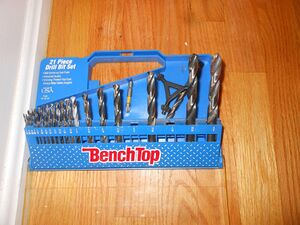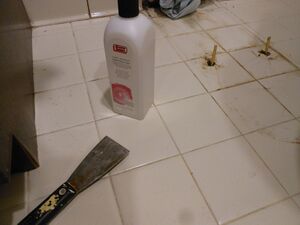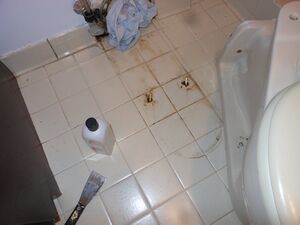Epoxy for Bathroom Bolt Replacement
This is a quick usage of epoxy to put new bolts into a preexisting tiled bathroom floor. In this scenario the old bolts were rusted out. This is a small project, but these tips/techniques can apply to larger usage of the epoxy.
Overview
The toilet has four bolts. Two on the back, and two on the bottom. It is a toilet which exits out the back. The two bottom bolts have rusted out over time. The two back bolts are still intact. The goal will be to remove the toilet from the floor, drill new holes into the floor, set new bolts in epoxy, let them cure overnight, then reattach the toilet to the room and plumbing.
Concerns:
- The old bolts will be rusted, only until they go into the floor, at which point they will be solid bolts.
- Replacement of the tile is not practical.
- The new bolts must be set in epoxy/glue/adhesive strong enough to keep the toilet from moving.
Items Needed
- Two Part Epoxy (Part A is base resin. Part B is hardener)
- Acetone (cleanup)
- Brass nuts and bolts of appropriate length
- Washers of appropriate size
- Wax Ring
- Basic tools for removal of toilet (wrench, screwdriver).
- A place to store the toilet while its not being used.
Work Log
Removal of toilet.
The removal of the toilet here is relatively easy. It required a flat head screwdriver (for tank bolts) and a rachet set to hold the bolt stead. There are also the drain bolts which require pliers or a wrench. The trickier part is putting it back together, without a leak.
Preparation
The area was cleaned. This toilet has the drain at the back, so the bottom was cleaned with bleach and water. Because the drain is on the back, it lacks the natural seal on the wax ring from gravity from vertical drain toilets. In this author's opinion, vertical drain toilets seem a better fit.
Items required were purchased from the hardware store. This job required at least:
- Brass bolts
- Brass nuts
- stainless or brass washers
- Two Part Epoxy
And you should have some basic tools, including a hand drill, and drill bits. The plan will be to drill a hole into the ceramic tile, fill the hole with epoxy, let cure, then do at least one more layer of epoxy after the first.
Buy different lengths of bolts. I bought 1.5" and 2". I ended up using the 2". What length to use will depend upon your floor. Also measure the toilet tank bolt hole diameter, and do not buy a bolt bigger than what will fit through the toilet!
Drilling into Tile
Drilling into tile seemed easy. The old bolts were still in the tile. I did not remove those, but drilled adjacent to them. Ideally I would've drilled through the old bolts (which were only rusted on top) but this proved too difficult without a drill press to stabilize. I ended up angling the bolts slightly, and tested a fit beforehand to confirm that it would work, by placing the toilet over the bolts which were blue taped into position.
Epoxy Layering
After placing the bolts, and mixing / pouring the two part epoxy, I used blue tape to hold the bolts in proper position. After at least 12 hours (I waited overnight) the bolts were checked, confirmed to be firm and then I gambled. I poured the next layer of mixed epoxy onto the base of the bolts, and then placed the toilet back on, while the bolts were still curing. I do not recommend this, but due to time constraints, I wanted to get the toilet back into working order.
By carefully placing the toilet, as to not break the first epoxy bond, I was then ready to re-assemble the toilet, and let the 2nd layer of epoxy fully cure. I waited again, overnight.
It should be noted that when placing the first layer of epoxy in the tile, and its subfloor (likely hardy board), that much of the first layer soaked into the subfloor. This was another reason for the 2nd coat. I wanted to ensure the bolts did not come loose. They were cured into the tile, but the left bolt was less so than the right. A 2nd layer, ensured the epoxy was set.
How Thick Can the Epoxy Be Layered?
I know from my experiments with silicone molds - not too thick. The epoxy we sell is not for making 3"x3"x3" cubes, it's for using as a protective layer for floors or similar such usage. Maybe 8mm thick is a good place to stay under.
Cleanup
Let me emphasize the necessity of acetone for cleanup.
Upon pouring the first layer, there was some overspill from the epoxy, as it settled into the tile/subfloor. This epoxy if not cured, would've put some millimeters on the tile, and possibly upset the toilet from sitting flat. Acetone is the best way to clean 'uncured' epoxy in this situation. It will clean up neatly, and can be purchased from Advance Coatings (better quality) or from Grocery Stores (low quality). See Acetone, for more details.
Reassembly of toilet
attachment of washer + nut tighten 'handtight', then finish with a few turns (not too many) with wrench. cleanup job complete
Conclusion: 12/2020
Some months after using the epoxy for toilet bolts, I ended up removing them. While they held ok, I made the mistake of not removing the initial bolts from the floor completely. What I should've done, is used some kind of stable drill press, in order to get a complete perpendicular drill to the floor. Or perhaps removed the previous bolts some other way. Because I did not line it up 1:1, the toilet was pulling slightly out.
Overall, I was pleased with the epoxy, but this kind of operation was delicate, and I imagine requires some care and experience to do reliably well. Adhering to a more solid subfloor such as plywood may work better as well.
What would a plumber do?
I asked the opinion of a plumber on how to replace such bolts, and he said they would simply drill down into the concrete with longer bolts, from the top of the toilet after installing. I then asked him, what would they do when the toilet needed to be removed, and he said drill even deeper bolts after replacing it. Of course, that can't go on forever, so at some point, you end up through the floor. (This is a limitation of my residence, and not of necessarily all homes). So it's possible, I had a better solution than the plumber. Although my execution was not perfect. His screws would've only been usable once (when screwed down from the top of an installed toilet).


